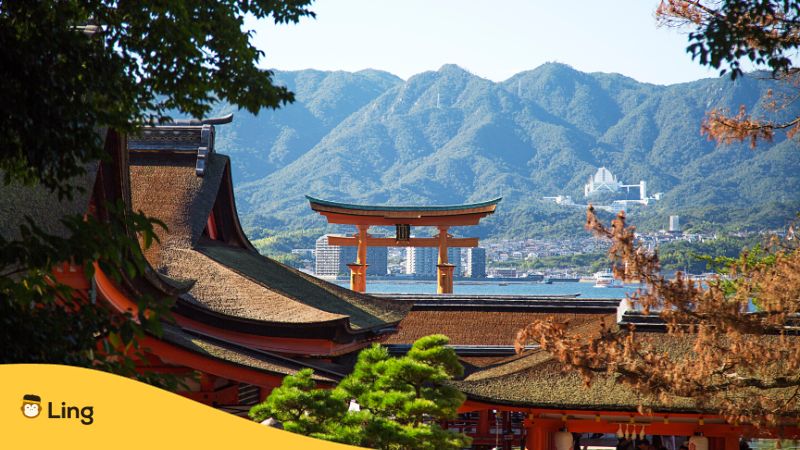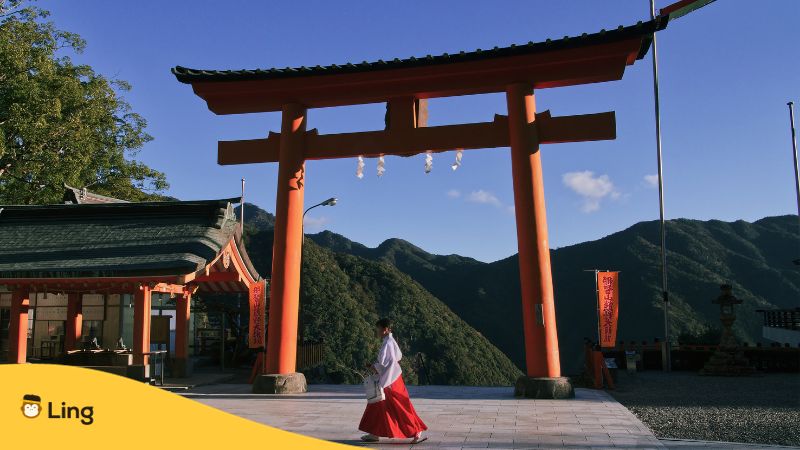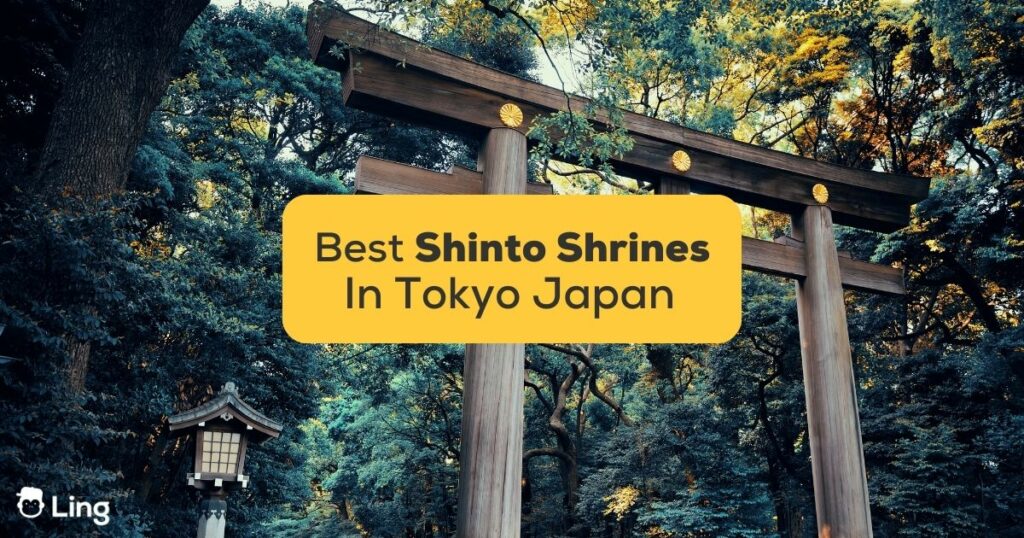Got Tokyo on the itinerary for your next big adventure? Awesome choice. As a frequent visitor to Japan’s mega city, let me let you guys in on a little secret – some of the most fascinating sights aren’t the flashy neon lights or bustling crowds, but the tranquil, spiritual Shinto shrines in Tokyo! You know… those tucked into neighborhoods across town!
I get it; coming all the way to Tokyo, you wanna see the latest tech and pop culture. For sure, for sure. But you know what they say, when in Rome! Or Tokyo, in this case. To truly understand this complex metropolis, you have to look past the giant anime billboards and maid cafes and spend some time exploring the Shinto roots underpinning it all.
Trust me, visiting these historic shrines totally transformed my perspective on Japan. I went seeking photos of beautiful torii gates and serene forest paths but ended up learning way more about the culture along the way. Before I knew it, I was hooked on all aspects of the Japanese language and life – the intricate religious beliefs, harmonious balance with nature, and strong traditions passed through generations.
Intrigued yet? Yeah, I thought so! In this blog, I’m recapping my five favorite Shinto shrines that gave me the most authentic window into old-world Tokyo. I’ll share some pro tips for making the most out of your visits too. Whether you’re a culture buff, an avid photographer, or just looking to briefly ditch the crowds, add these hidden gem sites to the top of your must-see list!
Table Of Contents

What Is A Shinto Shrine?
So before we get to the famous shrines, let’s chat about what a Shinto shrine (神社, jinja) actually is. Shinto is like Japan’s original, homegrown religion, around way before Buddhism made its way over. It revolves around purification rituals and honoring kami (神) or deities tied to nature/spirits.
Now, the ornate Buddhist temples around Tokyo are eye-catching in their own right. But Shinto shrines can be more modestly sized, though still profoundly sacred community sites. Their main purpose is facilitating bonds between people and their local kami guardians watching over that neighborhood.
The gorgeous vermilion torii (鳥居)gate at the entrance is an instant indicator you’ve found one. Inside you’ll commonly see two central structures. The haiden (拝殿) hall hosts ceremonies and offerings to kami where devotees pray and make requests.
Deeper in the shrine complex rests the even more holy honden (本殿) – the dwelling place of the enshrined kami’s spirit itself. Only priests interact with them here during rituals. But it’s amazing knowing an actual deity presence resides there!
Some places like the iconic Senso-ji Temple merge Buddhist temples with pre-existing Shinto shrines too. But to witness the roots of Japan’s spiritual origins still thriving today, these shrines offer the most potent dose of indigenous religion amidst modernization.

Shinto Shrines In Tokyo
Now get this – Tokyo alone has over 1400 Shinto shrines tucked away, large and small! From hidden mini shrines wedged between skyscrapers to huge complexes drawing millions of visitors, this city has got ’em all.
It’s pretty mind-blowing to realize that amidst the insane urban sprawl, many locals still faithfully hit up these community sites, the same as generations before them. Some even make yearly pilgrimages to the major shrines founded over 1000 years ago!
And the coolest thing for us travelers? We get to peek into vibrant living history and beliefs the city was originally built upon, not just the anime shops and robot restaurants (though those rule too, obviously).
Most neighborhoods have at least a tiny shrine or two, since they play a huge role for residents. But there’s a handful of supersized famous ones definitely worth prioritizing on your Tokyo bucket list.
Let’s get to know some of the best shrines below!
Meiji Jingu Shrine (Harajuku)
Location: 1-1 Yoyogikamizonochō, Shibuya City, Tokyo 151-8557, Japan
Alright, first up on the shrine tour is the one and only Meiji Jingu, the most famous and photogenic religious site in town! Located a short walk from lively Takeshita Street, it’s 100% worth dodging the Harajuku crowds for.
This sprawling forested oasis pays homage to Emperor Meiji and his wife, Empress Shōken, building an ever-impressive complex since 1920. Passing under the towering 12-meter wooden torii gate instantly transports you worlds away from the city.
Follow the serene wooded and gravel pathways deeper, like you’re trekking to a hidden ancient site built for gods! Make a stop to ritually purify yourself at a well if you wanna get the full experience.
You’ll eventually reach the Haiden main hall, the perfect spot to sit, soak up the sacred atmosphere and observe local rituals. End by exploring awe-inspiring gardens or checking seasonal Displays like votive sake barrels or epic Noh court dance costumes!
Whether you’ve got 30 mins or half a day, Meiji Jingu’s mix of architectural wow factor and peaceful natural retreat provides major “stepped into a Miyazaki film” vibes without leaving Tokyo city! Just be sure to mind signs banning loud chatter or photos in certain areas to avoid unwittingly angering resident spirits, lol.
Yasakuni-jinja Shrine (Imperial Palace Area)
Location: 3-chōme-1-1 Kudankita, Chiyoda City, Tokyo 102-0073, Japan
Next up on our spirit quest is Yasukuni-jinja, an important Shinto complex with roots going back to 1869 near the royal grounds. If you want to dive deeper into Japanese modern history along with religious practices, then visiting this site is a must!
Unlike our tranquil forest escape earlier, Yasukuni offers more solemn vibes while still showing off classic shrine architecture. Pass through the 25-meter-tall steel torii, then stop at the bronze statue honoring war widows to set the reflective tone.
The Haiden prayer hall itself was rebuilt in 1989, but the intricately decorated ceilings within give off serious old-school elegance. The on-site museum also offers a dense and, at times, controversial view into Japanese military history if interested.
For lighter explorations, the spacious grounds have lovely cherry and plum trees celebrated during Hanami season kickoffs. Or during the mid-August Obon week of honoring ancestral spirits, the shrine stays lit up each night for a mesmerizing summer view!
While it continues to have political controversy over former war leader memorials, experiencing Yasukuni’s legacy and witnessing persistent rituals for the fallen offers cultural insight you won’t find anywhere else in the capital. Just be ready for solemnity over serenity at this historic complex!
Kanda Myojin Shrine (Kanda)
Location: 2-chōme-16-2 Sotokanda, Chiyoda City, Tokyo 101-0021, Japan
If you’re looking to explore a historic shrine immersed right in Tokyo’s business and tech hub, then make tracks for Kanda Myojin! Dating back to 730 AD, this Shinto complex features ancient temples and even older deities fused with modern urban Japan.
Compared to the sprawling religious campuses we just toured, Kanda Myojin’s buildings squeeze neatly between offices and apartments. But don’t let the compact size fool ya – they packed a whole lotta spiritual history onto this plot!
Passing under the prominent vermilion gateway, you’ll spot locals paying respects through tossed coins, gentle bows, and smartphone prayers tapped to amulets. The vibe here feels more like a communal local hangout than a tourist destination.
On the flip side, don’t be surprised if you catch locals in business suits hurriedly ducking in to ask the prosperity god Daikokuten for career blessings! That just shows how intertwined spiritual tradition and daily life remain.
While it lacks lavish forest paths or ornate architecture, Kanda Myojin’s gritty urban energy makes up for that in spades. And hey, at least grabbing authentic soba noodles pre or post-prayers couldn’t get easier!
Asakusa-jinja Shrine (Asakusa)
Location: 2-chōme-3-1 Asakusa, Taito City, Tokyo 111-0032, Japan
At the epicenter of all the spiritual action is Asakusa Shrine, honored for centuries before getting dwarfed by the tourist-magnet Senso-ji Buddhist temple next door.
But true culture hounds know that to glimpse the OG foundations of Edo Tokyo, you’ve gotta pay respects to the Asakusa Shrine kami! Pass under the humble timber torii while taking in the traditional stores lining the path.
While it may lack towering gates or lavish decor, what Asakusa Shrine lacks in grandeur, it makes up for in enduring community spirit. Watch locals heft a miniature shrine during one of its 40 lively festivals held yearly, or show up hungry to nosh on food stall snacks after paying spiritual dues!
Compared to the world-famous Buddhist temple next door, this humble yet enduring site lets you envision daily faith before Tokyo transformed into a global megapolis. So embrace your inner pilgrim and explore Asakusa’s beating spiritual heart to complete your Shinto adventures!
Toshogu-jinja Shrine (Ueno)
Location: 9-88 Uenokōen, Taito City, Tokyo 110-0007, Japan
A 5-minute amble from the west exit of JR Ueno station leads you to towering karamon gates marking sacred ground. Pass through, then brace for jaw drops, viewing the intricately gilded honden containing Tokugawa Ieyasu’s spirit. Yup, THE influential shogun who transformed Edo into a powerhouse!
The gold leaf carvings of birds, flowers, and mythical creatures encrusting the structures are unreal enough back home. But seeing such lavish detail contrasted against Ueno’s urban landscape heightens surreal vibes even more!
While smaller scale than, say, Meiji Shrine, everything about this site speaks to the fortunes and authority it was built to represent. Be sure to peek at the wooden votive plaques stamped with samurai crests, too, for extra history immersion!
What makes Toshogu-jinja such a refreshing culmination of your journey is getting to admire such a well-preserved original shrine, untarnished by modern reconstructions. No crowds blocking photos or finding folk spirit fused with pop culture either – just pristine craftsmanship for that sweet taste of the Edo era, yeah?
Namiyoke Inari-jinja Shrine (Tsukiji)
Location: 6-chōme-20-37 Tsukiji, Chuo City, Tokyo 104-0045, Japan
Nestled in a nondescript side street near the former fish market, this unassuming shrine began protecting area workers from illness and accidents over 300 years ago. But one step through its vivid orange torii gate decorated with intricate carvings will wow you with an unexpected pocket of spirituality.
The most eye-catching draw has to be the lion heads guarding over the locals. These brightly-colored wooden beasts called “koma-inu” may look playful, but they serve the solemn duty of warding off evil spirits that may try to harass visitors and locals.
Nogi-jinja Shrine (Roppongi)
Location: 8-chōme-11-27 Akasaka, Minato City, Tokyo 107-0052, Japan
If modern neighborhoods like Roppongi are more your scene, you can still soak up history at General Nogi’s namesake shrine. Built in honor of the legendary military commander, it’s an oasis of tradition amidst clubs and condos.
Pass through the simple torii gate to enter a realm honoring virtues like honor and sacrifice – the general took his own life after Emperor Meiji’s death. Make sure to ring the gong and clap to grab the resident kami’s attention before peeking into the main hall.
Don’t miss the general’s original residence moved here back in the day! Check out the bullet holes left in the walls from WWII attacks – intense visible proof of the destruction Tokyo once faced.
While the compact forested grounds provide a nice urban escape, Nogi Shrine’s biggest claim to fame is the Chinese black pine. Planted when the complex was built, it still towers majestically, providing vivid green against the cityscape!
If you’re already exploring Roppongi’s cool side, like the art triangle or combo skyscrapers, take a breather among the pines at Nogi Shrine. It may not boast centuries of history or eye-popping architecture, but makes for a perfect pitstop to connect with nature amidst the neighborhood’s nonstop energy!
Navigating Shrine Signs And Translations
As you explore Tokyo’s famous shrines, keep an eye out for signs guiding proper etiquette or labeling key areas. Some complexes have English translations, but brushing up on a few basic Japanese terms can help deepen cultural appreciation.
First up, you’ll likely spot 清める (kiyomeru) on fountains or fonts near shrine entrances. This means “purification” and signifies ritual washing spots to cleanse hands and mouth before entering sacred grounds.
Next, watch for signs like 拝殿 (haiden) pointing towards the main hall for worship, housing deity images, and where ceremonies occur. You may see 本殿 (honden), too, indicating the inner sanctum restricted to priests and rites.
Keep an eye out when exploring for FRAGILE (also written もろい mROI), signaling particularly delicate displays. And, of course, there are always classic signs marking women 女性 (josei) and men 男性 (dansei) restrooms!
Lastly, when you inevitably need to jet, exit signs guide the way out, marking 出口 (deguchi). But hopefully, you’ll stay awhile at these mesmerizing spiritual sites before returning to Tokyo’s bustle!
Keep Exploring Japanese Culture And Language
I hope this whirlwind tour of Tokyo’s most magnificent and meaning-filled Shinto shrines has inspired you to keep engaging with authentic Japanese culture during your travels.
Beyond just snapping that perfect pic of vermilion Torii gates, take time to appreciate the everyday rituals and beliefs still woven into city life here. Grab a goshuin temple seal book and chat with locals for deeper connections. Attend a festival or sample traditional cuisine. Or simply sit a spell finding communal spirituality amidst the enormous urban energy.
And if you want to continue discovering the richness of Japan even after departing Tokyo, learning the language basics helps tremendously too for future visits. That’s why I always recommend travelers grab the user-friendly Ling app.
Whether you’ve got 15-minute ride-shares or lengthier bullet train trips, you can brush up on key travel phrases and culture tips through Lin’s engaging Japanese lessons. Its intelligent review algorithm makes retaining knowledge a breeze – so you’ll be speaking survival phrases in no time! Give it a try for FREE now!


































































